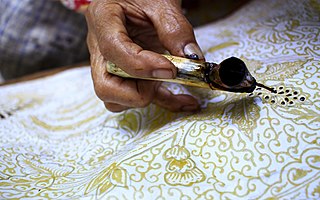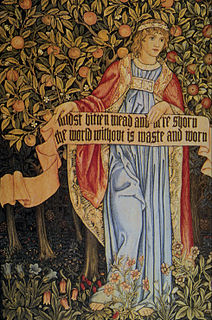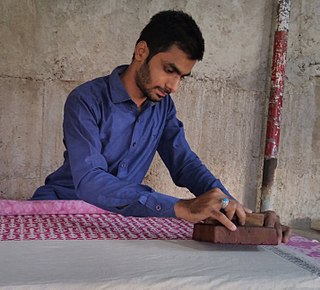
Calico is a heavy plain-woven textile made from unbleached, and often not fully processed, cotton. It may also contain unseparated husk parts. The fabric is far coarser than muslin, but less coarse and thick than canvas or denim. However, it is still very cheap owing to its unfinished and undyed appearance.

Denim is a sturdy cotton warp-faced textile in which the weft passes under two or more warp threads. This twill weaving produces a diagonal ribbing that distinguishes it from cotton duck. While a denim predecessor known as dungaree has been produced in India for hundreds of years, denim as it is recognized today was first produced in Nîmes, France.

Tie-dye is a term used to describe a number of resist dyeing techniques and the resulting dyed products of these processes. The process of tie-dye typically consists of folding, twisting, pleating, or crumpling fabric or a garment, before binding with string or rubber bands, followed by the application of dye or dyes. The manipulations of the fabric before the application of dye are called resists, as they partially or completely prevent ('resist') the applied dye from coloring the fabric. More sophisticated tie-dye may involve additional steps, including an initial application of dye before the resist, multiple sequential dyeing and resist steps, and the use of other types of resists and discharge.

Dyeing is the application of dyes or pigments on textile materials such as fibers, yarns, and fabrics with the goal of achieving color with desired color fastness. Dyeing is normally done in a special solution containing dyes and particular chemical material. Dye molecules are fixed to the fiber by absorption, diffusion, or bonding with temperature and time being key controlling factors. The bond between dye molecule and fiber may be strong or weak, depending on the dye used. Dyeing and printing are different applications; in printing, color is applied to a localized area with desired patterns. In dyeing, it is applied to the entire textile.

Morris, Marshall, Faulkner & Co. (1861–1875) was a furnishings and decorative arts manufacturer and retailer founded by the artist and designer William Morris with friends from the Pre-Raphaelites. With its successor Morris & Co. (1875–1940) the firm's medieval-inspired aesthetic and respect for hand-craftsmanship and traditional textile arts had a profound influence on the decoration of churches and houses into the early 20th century.

Textile printing is the process of applying color to fabric in definite patterns or designs. In properly printed fabrics the colour is bonded with the fibre, so as to resist washing and friction. Textile printing is related to dyeing but in dyeing properly the whole fabric is uniformly covered with one colour, whereas in printing one or more colours are applied to it in certain parts only, and in sharply defined patterns.

Textile geometry is the creative and technical process by which thread or yarn fibers are woven together or interlaced to form a flexible, functional, and decorative cloth or fabric which is subsequently printed upon or otherwise adorned. Textile design is further broken down into three major disciplines, printed textile design, woven textile design, and mixed media textile design, each of which utilize different methods to produce a surface ornamented fabric for variable uses and markets. Textile Design as a practice has evolved to become an industry integral to other disciplines such as fashion, interior design, and fine arts.

Kasuri (絣) is the Japanese term for fabric that has been woven with fibers dyed specifically to create patterns and images in the fabric, typically referring to fabrics produced within Japan using this technique. It is a form of ikat dyeing, traditionally resulting in patterns characterized by their blurred or brushed appearance.

Bagru is a town and a municipality in Jaipur district in the state of Rajasthan, India. It is located at a distance of 32 km from Jaipur, on Jaipur-Ajmer Road.

African textiles are textiles from various locations across the African continent. Across Africa, there are many distinctive styles, techniques, dyeing methods, and decorative and functional purposes. These textiles hold cultural significance and also have significance as historical documents of African design.

Ajrak, also known as Ajrakh, is a unique form of blockprinting found mostly in Sindh, Pakistan and Ajrakhpur, Kutch district, India. These shawls display special designs and patterns made using block printing by stamps. Over the years, ajraks have become a symbol of the Sindhi culture and traditions. Ajrak print is also famous in neighbouring areas of India in the state of Gujarat due to their influence from Indus Valley Civilization in Sindh, Pakistan. A similar ajrak type of shawl, Sajarak is found in South Punjab of Pakistan. Sajarak is mostly of cyan color while the simple Ajrak is of red and black.

Resist dyeing (resist-dyeing) is a traditional method of dyeing textiles with patterns. Methods are used to "resist" or prevent the dye from reaching all the cloth, thereby creating a pattern and ground. The most common forms use wax, some type of paste made from starch or mud, or a mechanical resist that manipulates the cloth such as tying or stitching. Another form of resist involves using a chemical agent in a specific type of dye that will repel another type of dye printed over the top. The best-known varieties today include tie-dye, batik, and ikat.

John Henry Dearle was a British textile and stained-glass designer trained by the artist and craftsman William Morris who was much influenced by the Pre-Raphaelite Brotherhood. Dearle designed many of the later wallpapers and textiles released by Morris & Co., and contributed background and foliage patterns to tapestry designs featuring figures by Edward Burne-Jones and others. Beginning in his teens as a shop assistant and then design apprentice, Dearle rose to become Morris & Co.'s chief designer by 1890, creating designs for tapestries, embroidery, wallpapers, woven and printed textiles, stained glass, and carpets. Following Morris's death in 1896, Dearle was appointed Art Director of the firm, and became its principal stained glass designer on the death of Burne-Jones in 1898.

Woodblock printing on textiles is the process of printing patterns on textiles, usually of linen, cotton or silk, by means of incised wooden blocks. It is the earliest and slowest of all methods of textile printing. Block printing by hand is a slow process. It is however, capable of yielding highly artistic results, some of which are unobtainable by any other method.

Roller printing, also called cylinder printing or machine printing, on fabrics is a textile printing process patented by Thomas Bell of Scotland in 1783 in an attempt to reduce the cost of the earlier copperplate printing. This method was used in Lancashire fabric mills to produce cotton dress fabrics from the 1790s, most often reproducing small monochrome patterns characterized by striped motifs and tiny dotted patterns called "machine grounds".

Natural dyes are dyes or colorants derived from plants, invertebrates, or minerals. The majority of natural dyes are vegetable dyes from plant sources—roots, berries, bark, leaves, and wood—and other biological sources such as fungi.

Sir Thomas Wardle was a British businessman, known for his innovations in silk dyeing and printing on silk. He collaborated with the designer William Morris, who visited his dyeworks in Leek, Staffordshire to learn how to use natural dyes. He was knighted by Queen Victoria for his services to the silk industry.
Sophia George is a British game designer who was the Victoria and Albert Museum's first video game designer-in-residence.

The British literary figure and designer William Morris (1834-1896), a founder of the British Arts and Crafts Movement, was especially known for his wallpaper designs. These were created for the firm he founded with his partners in 1861, Morris, Marshall, Faulkner and Company, and later for Morris and Company. He created fifty different block-printed wallpapers, all with intricate, stylised patterns based on nature, particularly upon the native flowers and plants of Britain. His wallpapers and textile designs had a major effect on British interior designs, and then upon the subsequent Art Nouveau movement in Europe and the United States.

William Morris (1834-1898), a founder of the British Arts and Crafts movement, sought to restore the prestige and methods of hand-made crafts, including textiles, in opposition to the 19th century tendency toward factory-produced textiles. With this goal in mind, he created his own workshop and designed dozens of patterns for hand-produced woven and printed cloth, upholstery, and other textiles.



















